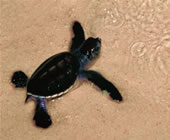




Green Turtle ConservationScientific name: Chelodina mydas IUCN Status: Endangered (at very high risk of extinction in the wild) CITES: Appendix I (international commercial trade banned) Habitat: Tropical and warm temperate seas. Forage in warm, shallow areas with abundant vegetation, including landward lagoons inside the reef. Conservation efforts: A number of organisations around the world are working to help these and other endangered marine turtles. One of the biggest challenges, and arguably the most important, is education. This includes education of visitors when purchasing goods, and of future generations in areas where these turtles occur. If locals are able to see an intrinsic value in the turtles, as well as the eco-tourism potential, they are more likely to work to save them. Other measures introduced to curb population declines in some areas include “Turtle Exclusion Devices” which reduce incidental by-catch in prawn trawling nets, tougher laws (although these are often not enforced) and re-release programs when turtles are captured in other types of fishing nets. About: Threats: Like Hawksbill turtles, Green turtles are threatened with extinction. They are killed and eaten when they come ashore and when caught in fishing nets, whilst eggs are poached from nests. Many of their nesting beaches are being destroyed by development. Where development does not directly encroach on nesting beaches, bright lights confuse emerging hatchlings which head further inland instead of out to sea, making them more vulnerable to predators. There is also a trade in their body parts and oil – the slaughtered remains of these beautiful animals are often seen in coastal areas. Sadly, despite CITES (Convention for International Trade in Endangered Species) restrictions, parts of these turtles are sold as ornaments and curios to tourists – particularly in Tanzania. Tourists often buy these curios unknowingly – so please be aware when you are shopping and remember not to purchase anything that is made from threatened or endangered species. |
Marine Turtle ConservationMonitor nesting turtles Turtle hatchling count
Learn more about Green Turtles |
|
|
||
All Rights Reserved
East
Africa Diving | Zanzibar | Mafia | Pemba | Africa Diving | Whale
Sharks | Mnemba Atoll | Indian Ocean Diving info@EastAfricaDiving.com Terms of Use. Privacy Policy. Brought to you by ConservationSafaris.com |
